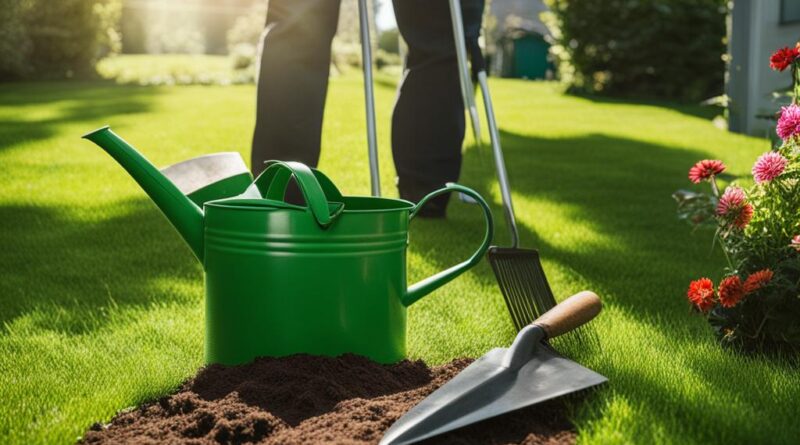Smart Lawn Care Hacks for Lush Grass
Want to achieve a lush and envy-worthy lawn? Look no further! In this article, we’ll share expert lawn care hacks and techniques that will transform your yard into a vibrant oasis. Whether you prefer to take a DIY approach or seek professional assistance, these strategies will help you maintain a healthy and beautiful lawn.
By implementing these efficient lawn care techniques, you’ll not only save time and effort but also enjoy the rewards of a vibrant, well-maintained lawn. From mowing tips to natural weed control, we’ve got you covered. So, grab your gardening tools and let’s dive in!
Key Takeaways:
- Keep your lawn mower blades sharp to ensure a clean cut and prevent damage to the grass.
- Set the right blade height to promote healthy growth and prevent weed infestation.
- Alternate mowing patterns to achieve a uniform and healthy lawn.
- Bag or leave grass clippings strategically, depending on the season, for a neater appearance or enhanced nutrient release.
- Consider hiring professionals for weed removal and fertilization to maximize the health and appearance of your lawn.
Remember, every lawn is unique, so adapt these hacks to suit your grass type and regional climate. With a little dedication and these smart lawn care techniques, you’ll soon be the envy of the neighborhood!
Keep Your Mower Blades Sharp
One of the key factors in maintaining a healthy lawn is keeping your mower blades sharp. Dull blades can cause ragged edges on the grass, leaving it vulnerable to pests and weeds. By regularly sharpening your blades, you can ensure clean and precise cuts that promote healthy growth.
Sharpening your mower blades at least twice per season is recommended for optimal results. This frequency may vary depending on factors like the size of your lawn and the type of grass you have. By maintaining sharp blades, you’ll not only enhance the appearance of your lawn but also support its overall health and resistance to common lawn issues.
“Dull blades can rip and tear the grass, creating wounds that invite pests and diseases to infiltrate the grass blades. These wounds also provide easy entry points for weed seeds, allowing them to establish and spread quickly.”
In addition to preventing pest infestation and weed growth, sharp blades also contribute to better lawn maintenance. When grass is cut with sharp blades, it heals more quickly, reducing the stress on the grass and promoting faster regrowth. This means you’ll spend less time and effort on lawn care tasks and enjoy a lush, healthy lawn throughout the year.
Remember to follow proper safety procedures when sharpening your blades or consider seeking professional assistance. A sharp blade not only ensures a beautiful lawn but also minimizes the risk of accidents or injuries while operating the mower.
Maintaining Blade Sharpness:
Here are some tips for keeping your mower blades sharp:
- Regularly inspect your blades for signs of wear or damage.
- Sharpen the blades with a file, grinder, or professional blade sharpener.
- Balance the blades after sharpening to ensure even cutting.
- Replace blades that are too damaged or worn beyond sharpening.
By prioritizing blade sharpness in your lawn maintenance routine, you can enjoy a beautiful, well-maintained lawn that enhances the overall appearance of your outdoor space.
| Benefits of Sharp Mower Blades | Consequences of Dull Blades |
|---|---|
|
|
Set the Right Blade Height
Properly setting the blade height of your lawn mower is crucial for maintaining healthy grass. Cutting the grass too low can weaken it, leaving it vulnerable to weeds and pests. On the other hand, if the grass is allowed to grow too tall, it can block sunlight and result in bare spots.
To ensure optimal lawn care, set your mower blades to trim no more than one-third of the grass length each time you mow. This helps preserve the grass’s energy reserves and promotes healthy growth.
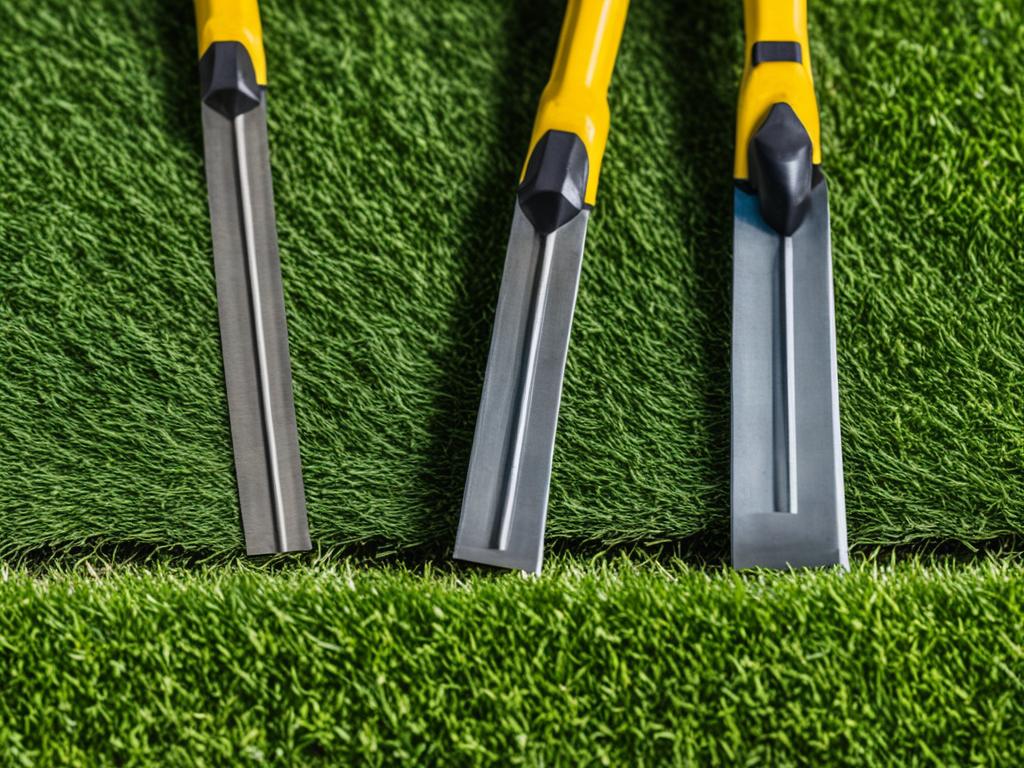
By maintaining the correct blade height, you allow the grass to maintain a good balance of leaf area and root system. This encourages stronger and deeper root growth, helping the grass absorb nutrients more efficiently.
Pro Tip: Adjust the blade height depending on the grass type and growing conditions. For warm-season grasses like Bermuda and Zoysia, setting the blades slightly lower may be beneficial. However, cool-season grasses like Fescue and Kentucky Bluegrass should have a slightly higher blade height.
Benefits of Proper Blade Height
Setting the right blade height for your lawn mower offers several benefits:
- Promotes healthy grass growth by preserving the energy reserves of the grass
- Reduces weed and pest infestation by maintaining a stronger and healthier lawn
- Prevents scalping, which can lead to bare spots and uneven growth
- Improves the overall appearance and aesthetic appeal of your lawn
Proper blade height is a fundamental aspect of lawn care. It ensures that your grass remains healthy, vibrant, and capable of withstanding environmental stressors. Remember, a little adjustment in blade height can go a long way in maintaining a beautiful lawn.
| Grass Type | Ideal Blade Height (inches) |
|---|---|
| Bermuda Grass | 0.5-1 inch |
| Zoysia Grass | 1-1.5 inches |
| Fescue Grass | 2-3 inches |
| Kentucky Bluegrass | 2-3 inches |
Alternate Mowing Patterns
To maintain a uniform and healthy lawn, it is important to alternate your mowing patterns. Switch between horizontal, vertical, and diagonal directions with each mow. This allows the grass to grow evenly and prevents compaction in one area.
Regularly changing the direction of your mowing patterns helps prevent the grass from leaning in one direction, which can create an uneven appearance. It also helps to distribute sunlight, water, and nutrients more evenly across the lawn, promoting healthy grass growth.
When mowing in different directions, be mindful of any obstacles or challenging areas in your yard. Take extra care when maneuvering around trees, flower beds, or other landscape features to avoid damaging the grass or surrounding plants.
Consider using a striping kit or roller attachment on your mower to enhance the visual impact of alternating mowing patterns. These accessories create distinctive patterns on the grass, adding an aesthetic appeal to your lawn.
Remember to adjust your cutting height based on the grass type and seasonal conditions. Cutting the grass too short can stress the roots and hinder grass growth, while leaving it too long can lead to a thatched appearance and encourage weed growth.
Achieving Lawn Uniformity
By employing various mowing patterns, you can achieve a uniform and visually appealing lawn. The different directions and angles of the mowing lines create a striped or checkerboard effect, giving your lawn a professional and well-maintained look.
Here’s an example of alternating mowing patterns:
| Mowing Pattern | Appearance |
|---|---|
| Horizontal | |
| Vertical | |
| Diagonal |
By alternating between these patterns, you can achieve a well-groomed lawn with a consistent and attractive appearance. Additionally, changing your mowing direction can help prevent ruts or low spots in your lawn caused by repeatedly mowing in the same direction.
Remember to switch up your mowing patterns regularly to maintain lawn uniformity and encourage healthy grass growth.
Bag Grass Clippings Strategically
Grass clippings can play a vital role in maintaining the appearance and health of your lawn. Depending on the season, it is important to strategically decide whether to bag or leave the clippings on your lawn.
During the spring and fall, it is beneficial to bag the grass clippings. Bagging helps remove excessive thatch, preventing it from suffocating the grass and hindering its growth. By collecting the clippings, you can create a neater and more uniform lawn appearance.
However, in the summer, it’s a different story altogether. Leaving the grass clippings on the lawn can be highly beneficial.
In the summer months, grass clippings act as a natural mulch layer when left on the lawn. This layer helps retain moisture, reducing the need for frequent watering and promoting water conservation. Moreover, as the clippings decompose, they release essential nutrients back into the soil, providing a natural fertilizer for your lawn.
By leaving the grass clippings on your lawn during the summer, you can improve the overall health and nutrient content of your soil, leading to a greener and more vibrant lawn.
| Season | Grass Clippings |
|---|---|
| Spring and Fall | Bag the clippings to remove thatch and maintain a neater appearance. |
| Summer | Leave the clippings on the lawn to release nutrients and improve moisture retention. |
Hire Professionals for Weeds Removal and Fertilization
Despite implementing proper mowing techniques, some lawns may require the expertise of professional lawn care services for effective weed removal and fertilization. By availing the services of a reputable lawn care company, you can ensure that your lawn receives expert treatment, promoting its overall health and appearance.
Professional lawn care providers have in-depth knowledge of various weed species and fertilizers, allowing them to tailor their approach based on your lawn’s specific needs. They employ proven techniques and high-quality products to eradicate weeds effectively and promote robust grass growth.
One of the primary advantages of hiring professionals for weed removal is their ability to differentiate between various weed species. This knowledge is essential because different weed types require specific treatment methods. By accurately identifying and targeting the weeds in your lawn, professional lawn care providers can ensure efficient and long-lasting results.
Fertilization is another crucial aspect of maintaining a healthy lawn. Professional lawn care services have access to premium fertilizers that can address nutrient deficiencies and promote optimal grass growth. They analyze your lawn’s nutrient levels and develop a customized fertilization plan to restore and enhance its vitality.
Additionally, professional lawn care companies have the necessary equipment and resources to apply fertilizers evenly and at the appropriate times. This ensures that each area of your lawn receives the required nutrients, leading to consistent and lush growth.

Investing in professional weed removal and fertilization services not only saves you time and effort but also yields superior results. These experts possess the knowledge, experience, and specialized tools needed to transform your lawn into a healthy and weed-free oasis.
Remember, a well-maintained lawn not only enhances the curb appeal of your property but also creates a welcoming outdoor space for you and your loved ones to enjoy.
Wetting Agents for Better Watering
When it comes to efficient lawn watering, wetting agents can be a game-changer. These agents, commonly used on golf courses, improve water absorption in the soil, ensuring that water reaches the plant roots effectively. If you don’t have access to commercial wetting agents, there’s no need to worry. You can use a simple household item as a substitute.
Dish soap, yes, you read that right! Household dish soap can be a cost-effective alternative to wetting agents. It acts as a surfactant, breaking down the surface tension of water and allowing it to penetrate the soil more easily. It works especially well on trouble spots with compacted soil or areas that tend to dry out quickly.
Caution: While dish soap can be a handy substitute for wetting agents, it’s essential to use caution with certain grass types. Some grasses can be sensitive to soap residue, which may cause damage over time. Before applying dish soap to your entire lawn, it’s recommended to test a small area first and observe the results.
| Benefits of Wetting Agents | Benefits of Dish Soap Substitute |
|---|---|
|
|
Using wetting agents or a dish soap substitute can optimize your watering efforts and ensure your lawn receives the water it needs. Whether you choose to invest in commercial wetting agents or utilize a simple household solution, these techniques will help you achieve efficient and effective lawn watering.
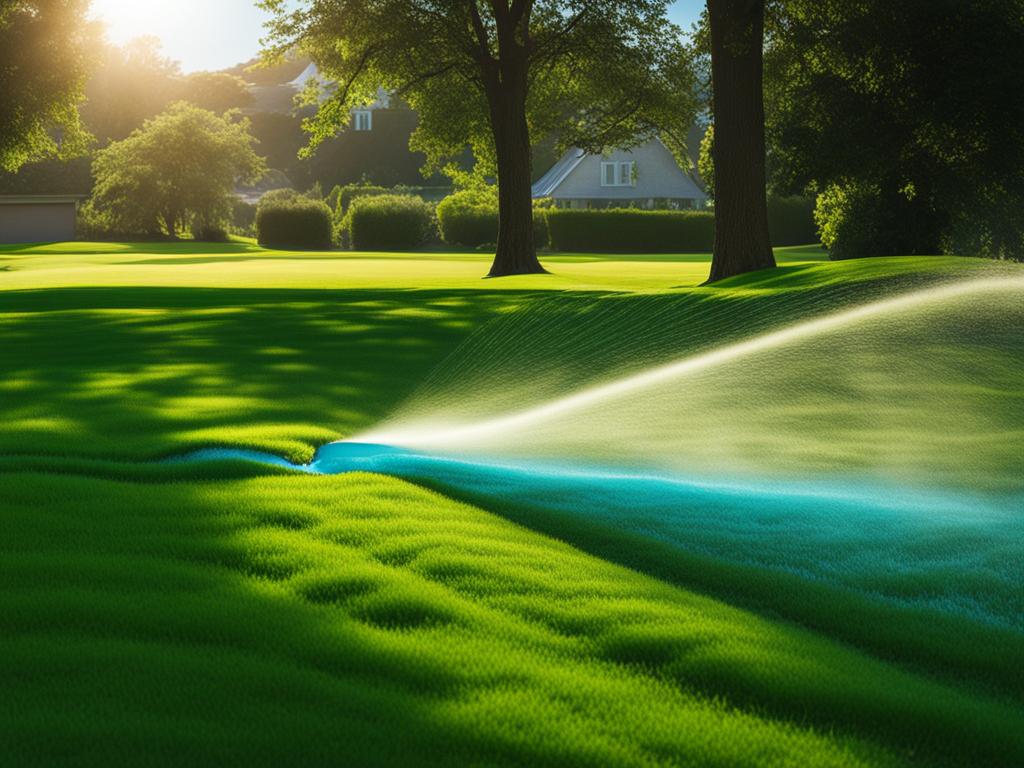
Salt and Vinegar Weed Killer
If you’re looking for a natural and effective way to control weeds in your lawn, consider using a homemade weed killer made from common household ingredients. A mixture of white vinegar, salt, and dish soap can be a powerful tool in your weed control arsenal.
To create this homemade weed killer, follow these simple steps:
- Mix 1 gallon of white vinegar, 1 cup of salt, and 1 tablespoon of dish soap in a large container.
- Stir the mixture until the salt is dissolved.
- Transfer the solution to a spray bottle or garden sprayer for easy application.
When applying the salt and vinegar weed killer, it’s important to target the weeds directly while avoiding contact with the surrounding lawn. Thoroughly spray the solution onto the weed’s leaves and stems, ensuring full coverage.
Caution: Take care not to use excessive salt, as it can hinder desirable plant growth and damage the soil. Additionally, this method is best suited for spot treating weeds in small areas and should not be used as a broad-scale weed control solution.
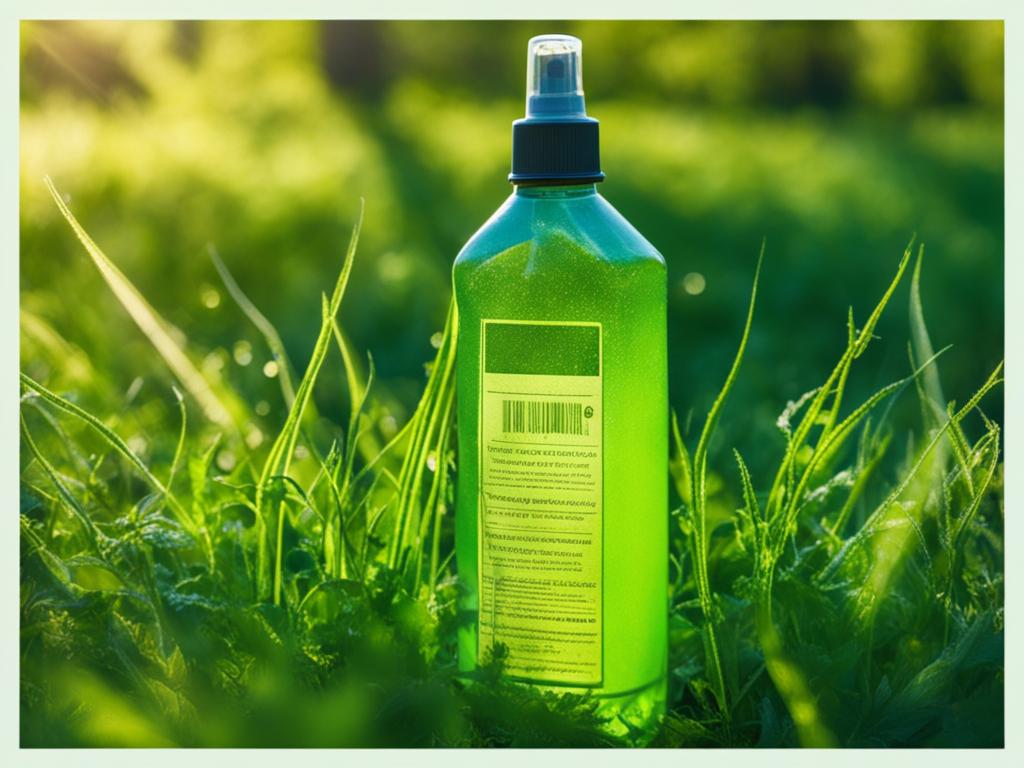
Utilize Grass Clippings as Natural Fertilizer
When it comes to lawn maintenance, don’t overlook the power of grass clippings as a natural fertilizer. Instead of disposing of them, leaving them on your lawn can provide valuable nutrients that promote healthy growth. This environmentally-friendly practice not only benefits your lawn but also reduces the need for additional chemical fertilizers.
To make the most of grass clippings, consider using a mulching mower. These innovative machines are designed to cut the grass into smaller pieces that can easily decompose and release nutrients back into the soil. Through this natural process, your lawn receives a steady supply of essential elements like nitrogen, phosphorus, and potassium.
By using grass clippings as natural fertilizer, you contribute to the overall health and vitality of your lawn. The nutrients provided by the clippings help the grass to grow stronger, develop deeper roots, and improve its ability to withstand environmental stressors. Additionally, the decomposing clippings can enhance soil fertility and moisture retention, reducing the frequency of watering and conserving water in the long run.
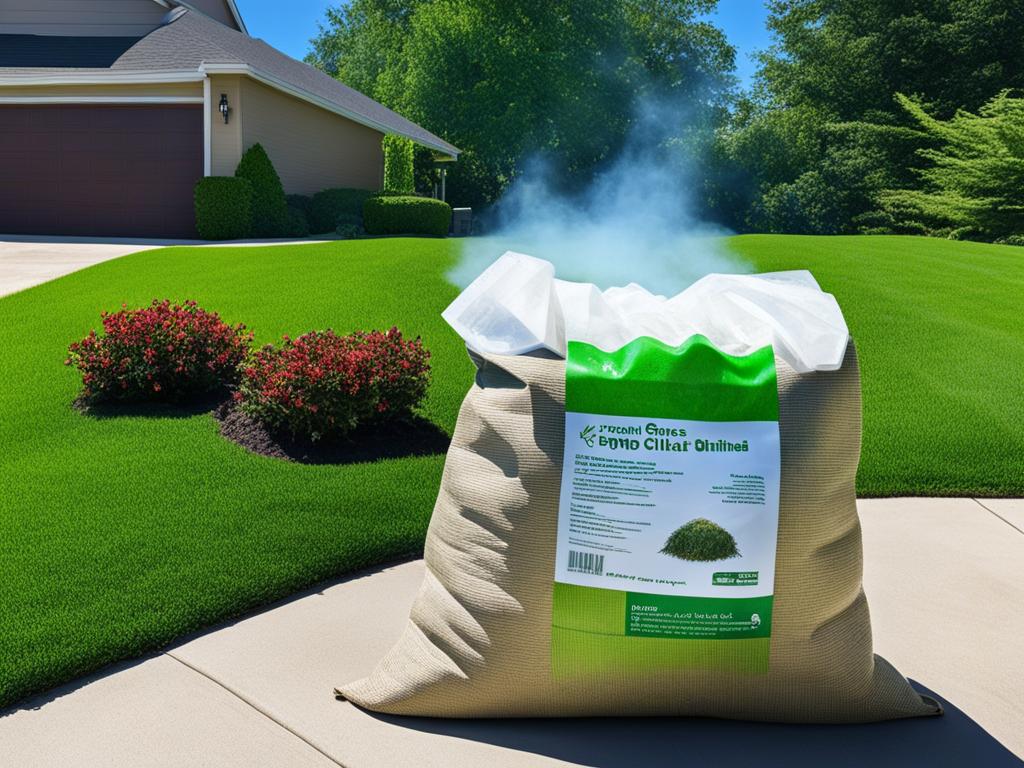
To effectively utilize grass clippings as natural fertilizer, follow these tips:
- Ensure that the grass clippings are free from weeds and debris.
- Mow your lawn regularly, aiming to cut off no more than one-third of the grass height each time.
- Spread the grass clippings evenly across your lawn, creating a thin layer. Avoid clumping or piling up the clippings, as this can block sunlight and lead to grass damage.
- Avoid applying excessive amounts of grass clippings, as this can suffocate the grass and create an unsightly appearance.
- Water your lawn after applying the grass clippings to help them settle into the soil and release their nutrients.
Incorporating grass clippings as natural fertilizer into your lawn care routine not only promotes the health and beauty of your grass but also contributes to a more sustainable and eco-friendly approach to landscaping.
Efficient Leaf Raking Techniques
Leaf raking is an essential task in maintaining a clean and well-kept yard. To make the process more efficient and manageable, consider the following techniques:
- Work with the wind: When raking leaves, pay attention to the direction of the wind. By raking in the same direction as the wind, you can prevent the leaves from blowing back into piles you have already gathered, saving you time and effort.
- Gather leaves into lines: Instead of creating large piles of leaves, try gathering them into lines. This allows you to easily bag or move the leaves without having to disassemble a big pile. It also improves efficiency by reducing the overall volume of leaves.
- Choose the right rake: Using a rake with an angled tine design and wide spread can prevent clogging and make the task of raking leaves easier. These types of rakes are specifically designed to handle leaf raking and can help you complete the job more efficiently.
Expert Tip:
“When raking leaves, try to maintain a consistent pace and use your body’s momentum to your advantage. Bend your knees, engage your core, and use your leg muscles to generate power while raking. This can help reduce strain on your back and make the process more efficient.”
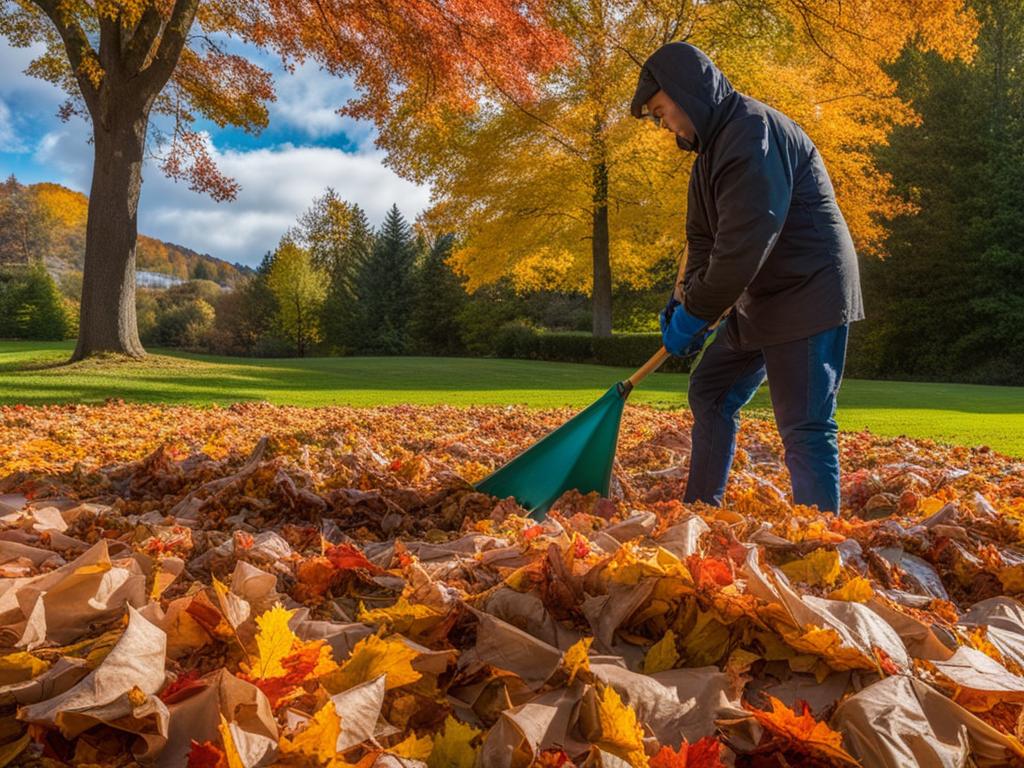
Aerify Your Lawn for Optimal Growth
Aerifying your lawn is a crucial step in lawn care that can significantly benefit the overall health and appearance of your grass. By creating small holes in the soil, aerification improves oxygen flow and enhances nutrient absorption, leading to lush and vibrant grass.
While there are machines specifically designed for aerating large areas, manual methods can be employed for smaller sections of your lawn. A sharp knife or a kitchen fork can effectively penetrate the soil, creating the necessary holes for improved oxygen and nutrient circulation. Simply insert the tool into the ground, making sure to space the holes evenly.
Regularly aerating your lawn is especially important in high-traffic areas, such as where kids play or where pets frequently roam. These areas are more prone to soil compaction, which restricts oxygen flow and hinders nutrient absorption. Aerification helps alleviate compaction and keeps your grass healthy and resilient.
Benefits of Aerifying Your Lawn
Aerifying your lawn provides numerous benefits that contribute to its overall vitality:
- Improved oxygen flow to the grass roots, promoting healthier growth
- Enhanced nutrient absorption, allowing the grass to access essential elements for optimal development
- Reduced soil compaction, preventing water runoff and enhancing moisture retention
- Stimulated root growth, leading to a stronger and more resilient lawn
To further illustrate the advantages of aerification, here is a visual representation of the effects:
| Without Aerification | With Aerification |
|---|---|
| Restricted oxygen flow | Increased oxygen flow, promoting healthy growth |
| Impaired nutrient absorption | Enhanced nutrient absorption, maximizing lawn health |
| Soil compaction | Reduced soil compaction, improving moisture retention |
| Weaker root system | Stimulated root growth, creating a strong and resilient lawn |
As you can see, aerifying your lawn can have a significant impact on your grass’s health and appearance. Incorporating aerification into your regular lawn care routine will ensure optimal growth and a lush lawn that you can be proud of.
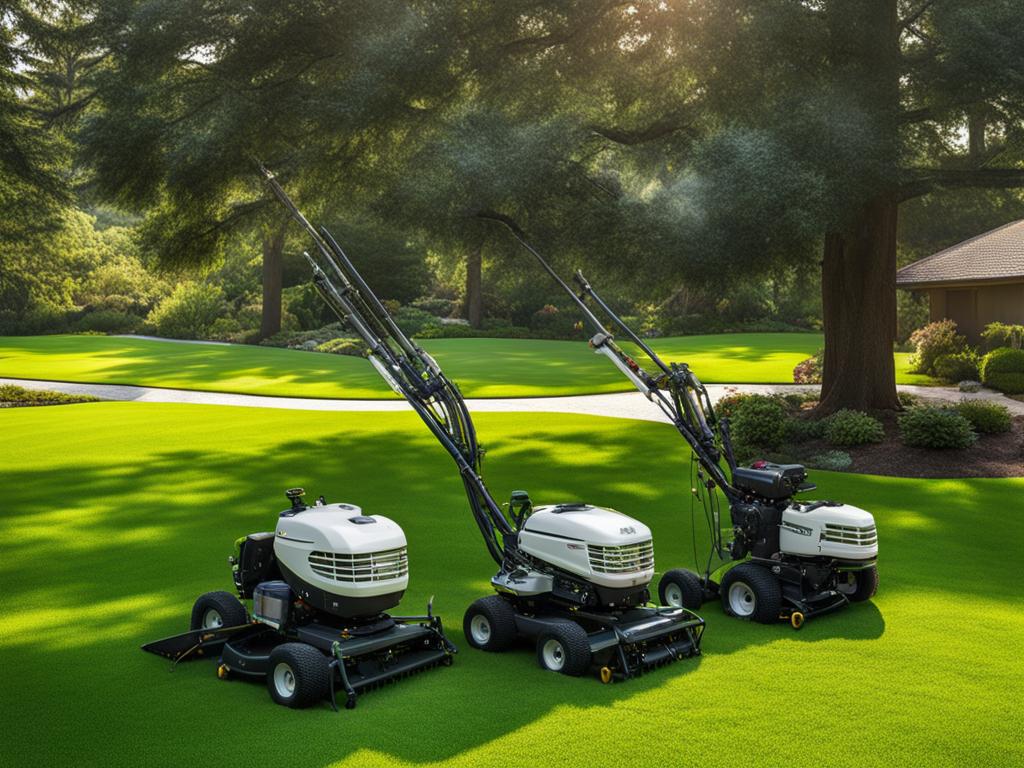
Protecting Plants and Lawns from Frost
When frosty weather sets in, it’s crucial to take measures to protect your delicate plants and lawns. Instead of using environmentally harmful Styrofoam cups or plastic covers, opt for a more sustainable solution that also maintains a visually pleasing appearance. Simply cover vulnerable plants and lawns with bed sheets to shield them from frost damage.
“Using bed sheets as frost protection not only safeguards your plants and lawns but also adds a touch of rustic charm to your winter landscape.”
By carefully draping the sheets over your plants and lawns, you create a protective barrier against the freezing temperatures. The sheets serve as insulation, preventing frost from directly contacting the plant tissue and causing damage. Additionally, this method allows for some air circulation, reducing the risk of moisture buildup and fungal diseases.
It’s important to use this method sparingly and selectively to avoid an excessive winter camping look. Reserve it for your most vulnerable plants and lawns, such as delicate flowers, newly planted seedlings, or sensitive grass species.
By choosing this eco-friendly option, you not only protect your plants and lawns but also contribute to the preservation of the environment. Bed sheets can be easily reused and, unlike Styrofoam cups, won’t contribute to litter.
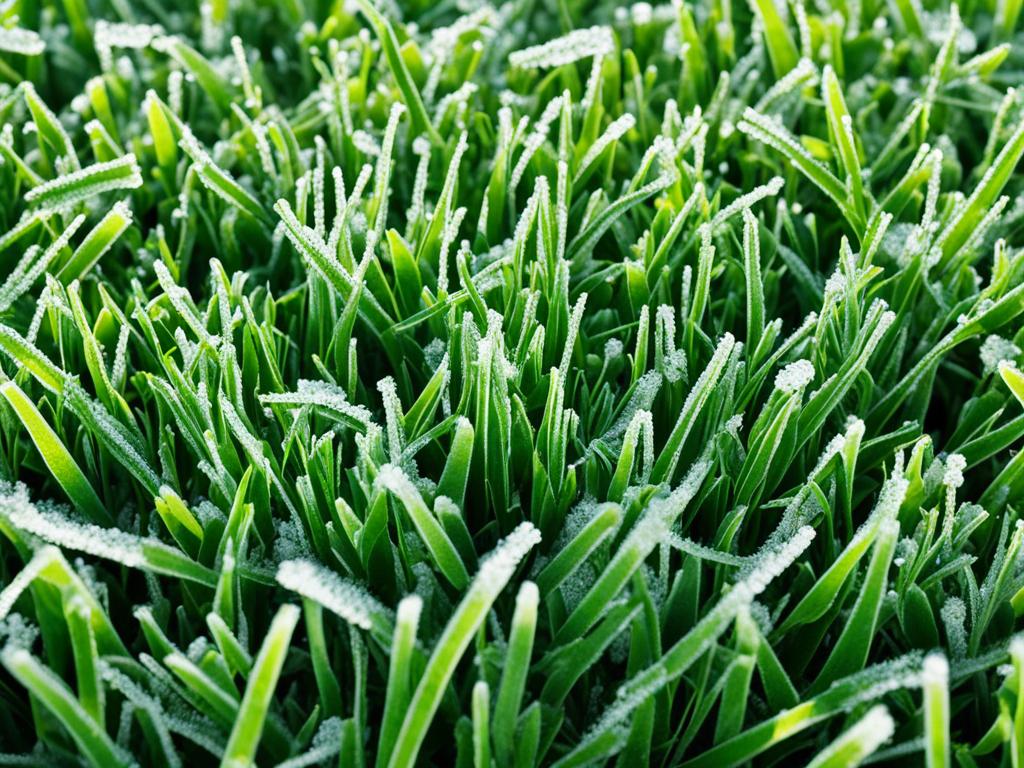
With this method, you can enjoy peace of mind knowing that your beloved greenery is shielded from the harsh effects of frost. Implement this simple yet effective technique to safeguard your plants and maintain their health and vitality throughout the winter season.
Essential Lawn Care Tasks
In addition to the aforementioned hacks, maintaining a healthy and lush lawn requires regular essential lawn care tasks. By following these tips and guidelines, you can ensure optimal lawn maintenance and achieve the best results for your outdoor space.
1. Soil Testing
One of the first steps in lawn care is to test your soil. Soil testing helps determine the pH level and nutrient deficiencies that may be affecting the health and growth of your grass. You can either purchase a home testing kit or send samples to a professional lab for analysis. Based on the test results, you can adjust your fertilization and treatment plans accordingly.
2. Appropriate Fertilization
Fertilizing your lawn is essential for providing the necessary nutrients it needs to thrive. Different types of grass have varying fertilization requirements, so it’s important to choose the right type and apply it according to the recommended schedule. Follow the instructions on the fertilizer packaging, considering factors such as grass type, climate, and soil conditions. Remember to water your lawn after fertilization to ensure proper absorption.
3. Addressing Calcium Deficiencies
Calcium is an important mineral for healthy grass growth. If your soil lacks sufficient calcium, it can lead to issues like yellowing or stunted growth. Adding lime to the soil can help address calcium deficiencies and restore the pH balance. However, it’s important to test the soil before applying lime to ensure the pH level is appropriate. Consult with a professional or refer to soil testing results for accurate recommendations.
4. Adding Organic Matter
Incorporating organic matter into your soil can greatly improve its structure and fertility. Organic matter such as compost, grass clippings, or decomposed leaves enriches the soil with essential nutrients and improves its ability to retain moisture. Regularly apply a thin layer of organic matter on your lawn, ensuring it is well-distributed and does not suffocate the grass.
5. Preventing Crabgrass and Weeds
Crabgrass and weeds can quickly take over your lawn if not properly controlled. Implement preventive measures such as applying pre-emergent herbicides early in the spring to stop weed seeds from germinating. Regularly remove any emerging weeds manually or using herbicides specifically targeted for the types of weeds prevalent in your area. Maintaining proper lawn health through regular mowing, watering, and fertilization also helps prevent weed growth.
6. Mower Blade Sharpening
Maintaining sharp mower blades is vital for clean and healthy grass cuts. Dull blades can lead to ragged and uneven edges, increasing the risk of disease and stress on your lawn. Sharpen your mower blades at least once per season or more frequently if needed. This ensures precise cuts and promotes faster grass recovery.
7. Proper Mowing Height
Setting the correct mowing height is crucial for maintaining a healthy lawn. Each grass type has an ideal height at which it should be mowed to promote optimal growth and prevent stress. Mowing too low can weaken the grass and leave it vulnerable to diseases and weeds, while mowing too high can shade the lower parts of the grass and inhibit growth. Determine the recommended mowing height for your specific grass type and adjust the mower accordingly.
Incorporating these essential lawn care tasks into your regular maintenance routine will ensure that your lawn remains healthy, vibrant, and the envy of the neighborhood.
| Lawn Care Task | Importance |
|---|---|
| Soil Testing | To determine pH level and nutrient deficiencies |
| Appropriate Fertilization | To provide necessary nutrients for lawn health |
| Addressing Calcium Deficiencies | To ensure proper grass growth and prevent issues |
| Adding Organic Matter | To improve soil structure and fertility |
| Preventing Crabgrass and Weeds | To maintain a weed-free and healthy lawn |
| Mower Blade Sharpening | To ensure clean and precise grass cuts |
| Proper Mowing Height | To promote optimal grass growth and health |
Conclusion
By implementing these smart lawn care hacks, you can achieve and maintain a lush, healthy, and envy-worthy lawn. Keeping your mower blades sharp ensures clean cuts and prevents damage to the grass. Setting the right blade height prevents stress on the lawn and promotes optimal growth.
Alternating mowing patterns ensures even growth and reduces compaction. Strategically bagging or leaving grass clippings on the lawn depending on the season enhances appearance and nutrient absorption. Hiring professionals for weed removal and fertilization ensures expert care and the best results.
Using wetting agents or household dish soap can improve water penetration. A homemade weed killer made of vinegar, salt, and dish soap can effectively control weeds. Utilizing grass clippings as natural fertilizer reduces the need for additional nutrients. Efficient leaf raking techniques make yard cleanup easier.
Aerifying the lawn enhances oxygen and nutrient flow, while covering plants and lawns with bed sheets protects them from frost. Lastly, implementing essential lawn care tasks, such as soil testing, proper fertilization, and preventive measures against crabgrass and weeds, ensures long-term lawn health.
Remember to adapt these techniques to suit your specific grass type and regional climate for optimal results. By following these smart lawn care hacks, you can enjoy a vibrant, thriving lawn that will be the envy of your neighborhood.
FAQ
How often should I sharpen my mower blades?
It is recommended to sharpen your mower blades at least twice per season.
What is the ideal grass length to mow?
Set your mower blades to trim 1/3 of the grass length each time for proper maintenance.
Why is it important to alternate mowing patterns?
Alternating mowing patterns allows the grass to grow evenly and prevents compaction in one area.
Should I bag or leave grass clippings on my lawn?
Bagging clippings during spring and fall helps remove thatch, while leaving clippings on the lawn in the summer can release nutrients.
When should I hire professionals for weed removal and fertilization?
It is best to hire professionals when your lawn requires expert treatment for weed removal and fertilization.
Can household dish soap serve as a substitute for wetting agents?
Yes, household dish soap can be sprayed on trouble spots to enhance water penetration.
Is vinegar and salt an effective homemade weed killer?
Yes, a mixture of vinegar, salt, and dish soap can be an effective homemade weed killer.
Can I use grass clippings as natural fertilizer?
Yes, leaving grass clippings on your lawn can serve as natural fertilizer.
What are some efficient leaf raking techniques?
Work with the wind, gather leaves into lines, and use a rake with an angled tine design for easier leaf raking.
How can I aerify my lawn?
Use a machine or manual methods like using a sharp knife or kitchen fork to improve oxygen and nutrient flow to the grass roots.
How can I protect plants and lawns from frost?
Cover vulnerable plants and lawns with bed sheets during frosty weather for protection.
What are some essential lawn care tasks?
Test your soil, fertilize appropriately, address calcium deficiencies, add organic matter, and take preventive measures against crabgrass and weeds. Regular mower blade sharpening and proper mowing height are also important.

